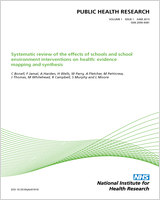Included under terms of UK Non-commercial Government License.
NCBI Bookshelf. A service of the National Library of Medicine, National Institutes of Health.
Barber SE, Akhtar S, Jackson C, et al. Preschoolers in the Playground: a pilot cluster randomised controlled trial of a physical activity intervention for children aged 18 months to 4 years. Southampton (UK): NIHR Journals Library; 2015 May. (Public Health Research, No. 3.5.)

Preschoolers in the Playground: a pilot cluster randomised controlled trial of a physical activity intervention for children aged 18 months to 4 years.
Show detailsThe aim of this document is to describe the process and calculations that have been applied to determine the minimum accelerometer wear time (daily wear hours and number of wear days) for participants of the PiP pilot trial. This document is directly addressing the following statement within the PiP protocol:
Data presented in this document were used by members of the internal steering group to decide what wear-time criterion will be applied to the accelerometer-derived data.
Methods
The PiP baseline data were cleaned and processed using Actigraph (v6) software according to the protocol described in Chapter 2, Objective 4: Feasibility of collecting the outcome measures and whether or not there was a difference between trial arms and ethnic groups and Objective 9: The effect of participation in the intervention on health outcomes and whether or not there were any differences between ethnic groups.
Data for participants who wore the accelerometer for a minimum of 3 days and with a daily wear time of 3 hours, 4 hours, 5 hours, 6 hours, 7 hours, 8 hours and 9 hours were separately scored using the Actilife software and were then exported to Microsoft Excel (2010; Microsoft Corporation, Redmond, WA, USA) for further data cleaning (comparison with wear-time logs). Using data from a minimum of 3 days with a minimum of 3 hours of wear time, paired t-tests or Wilcoxon matched-pairs tests between weekday and weekend day wear time, physical activity [TPA, moderate physical activity (MPA), LPA, vigorous physical activity (VPA)] and sedentary time were conducted to establish whether or not inclusion of a weekend day is required within the reliability analyses. Comparison tests were also conducted for the percentage of time being spent in TPA and MVPA (%TPA and %MVPA); this was so the confounding factor of wear time is controlled for.
To establish wear-time reliability specific written coding for Stata version 12 was used to randomly choose 3 days of data out of the different hourly increments for each participant. Single-day ICCs (two-way mixed models and absolute agreement) were then calculated using IBM SPSS Statistics version 21 (IBM Corporation, Armonk, NY, USA) for %TPA, %LPA, %MVPA and %sedentary time. The Spearman–Brown prophecy formula (see below) was then applied to determine the number of days required at each of the estimated single-day ICC values to meet reliabilities of 0.7 and 0.8. To establish a minimum wear time all results calculated by the Spearman–Brown prophecy formula were rounded up; therefore, both 2.1 and 2.7 were rounded up to 3 (days). If the weekend compared with weekday analysis concluded that there were any differences between weekdays and weekends then the process was repeated but with 2 weekdays and 1 weekday chosen at random.
Spearman–Brown prophecy:
For example:
Results
Table 48 describes the physical activity data from participants (n = 125) who have at least 3 days of data with a minimum 3 hours of wear time.
TABLE 48
Time (minutes) spent in physical activity
Table 49 presents the results of the comparison tests between weekdays and weekends. There was no significant difference between the amount of wear time during weekdays and the amount of wear time during weekend days, although the p-value was not too far from being significant (p = 0.09). The only significant differences between weekdays and weekends were found for TPA and LPA; however, when controlling for wear time, TPA (%TPA) was not significantly different, although LPA (%LPA) was.
TABLE 49
Comparison tests of wear time and physical activity between weekdays and weekends
From these findings and also considering that the sample number was reduced from 125 to 103 to include those participants with both weekday and weekend days, it is logical not to have a wear-time criterion that must include weekend days.
Table 50 outlines the single-day ICCs and the estimated number of days calculated by the Spearman–Brown prophecy formula required to reach reliabilities of 0.7 and 0.8. For %TPA, %MVPA and %sedentary time, a wear time of 6 or 7 hours requires 3 days of wear to reach a reliability of 0.8. For %LPA, 4 days is required for reliability; however, %LPA is not the main outcome variable of the study. Results for 4 and 5 hours of wear time required different numbers of wear days to reach reliability for different variables. Additionally, choosing a wear time of 7 hours or longer drastically decreased the sample size. Looking at the results but also referring to the sample sizes stated within the table, 6 hours on any 3 days as the minimum wear time would be the best compromise.
TABLE 50
Number of wear hours required to reach reliabilities of 0.7 and 0.8
- Spearman–Brown prophecy methods and tables - Preschoolers in the Playground: a p...Spearman–Brown prophecy methods and tables - Preschoolers in the Playground: a pilot cluster randomised controlled trial of a physical activity intervention for children aged 18 months to 4 years
Your browsing activity is empty.
Activity recording is turned off.
See more...